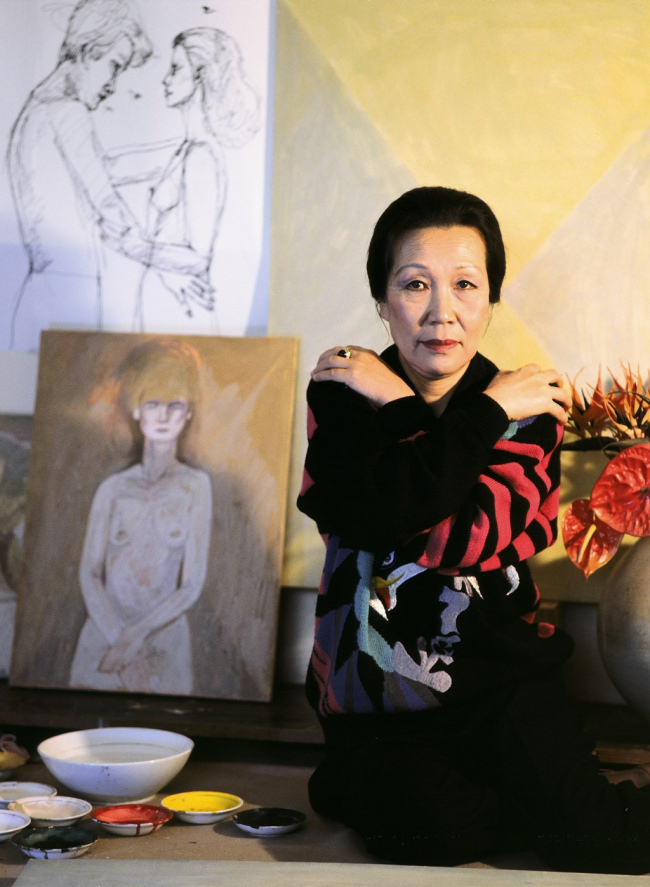[Newsmaker]Artist Chun's life, death shrouded in mystery
Female cultural icon, known for use of bold colors, died in August
By 이우영Published : Oct. 22, 2015 - 18:27
Artist Chun Kyung-ja, whose death in the past summer was revealed to the public Thursday, was a female cultural icon in Korea’s male-dominated art society.
According to the Seoul Museum of Art, Chun died on Aug. 6 in New York, where she had lived since 1998. The artist, who was 91, reportedly had a cerebral hemorrhage in 2003 and had suffered from poor health since then.
“It was reported to me that Chun’s daughter visited the museum on Aug. 20, carrying the remains of her mother,” Kim Hong-hee, director of the museum, was quoted as saying by Yonhap news agency. “At that time, she strongly asked (us) not to reveal her death to the public.”

The museum holds the largest number of Chun’s works following her donation of 93 pieces in 1998. Some of the works are on display at a permanent exhibition there.
Best known for her 1977 work “Page 22 in My Sorrowful Legend,” a portrait of a women with snakes, Chun’s unique art world had won much praise and fame, but her later life had been shrouded in scandals and mystery.
In 1991, she left her artistic career after a forgery scandal, moved to the U.S. and disappeared from the public eye, so much so that some had believed her to be dead for years.
Last year, the National Academy of Arts, a prominent circle of Korean artists, writers and poets, which Chun joined in 1978, temporarily stopped paying Chun her membership benefits, citing that it could not confirm whether she was dead or living. In protest, Chun’s daughter asked the NAA to withdraw her mother’s membership. The NAA requested Chun’s official medical records from her daughter to prove the artist was still alive. The daughter, surnamed Lee, refused to give the records. Chun is still listed as a member of the NAA on its official website.
Born in 1924 in Goheung, South Jeolla Province, Chun studied painting at a college in Tokyo. In 1945, only one year into college, she made her name known in the Korean art world by winning an award at the 22nd Joseon Art Exhibition with a portrait of her grandfather. She held her first solo exhibition at her high school in 1946, where she worked as an art teacher after returning from Tokyo.
She rose to fame in the Korean art world with her emotional snake painting “A Mode of Life,” portraying her feelings of despair in 1951, when she experienced divorce and the death of her sick sister and father at the same time. Snakes have been a “life-saving water which brought back memories of my hometown,” she wrote in an essay in 1996.
Chun is known for her bold use of colors for female portraits, paintings of flowers, animals and exotic landscapes, which she called reflections of her inner self. She once said: “Whether they are images of a person, or animals or plants, paintings are my other half.” The idea had been manifested in female portraits that resemble the artist regardless of their nationalities.
She traveled to many countries, including India, Mexico, Peru, Argentina and Brazil, which are believed to have had influence on her exotic paintings. She was also a writer, publishing autobiographical essays.
She was awarded the prestigious Silver Order of Cultural Merit from the Korean government in 1983.
The artist was mired in a forgery scandal in 1991. Chun claimed one of the paintings displayed at the National Museum of Modern and Contemporary Art was a copied work. The museum had the painting appraised, which proved it to be an authentic work of Chun. She rebutted the appraisal and suddenly decided to quit everything. She moved to live in New York in September 1998.
By Lee Woo-young (wylee@heraldcorp.com)







![[Graphic News] More Koreans say they plan long-distance trips this year](http://res.heraldm.com/phpwas/restmb_idxmake.php?idx=644&simg=/content/image/2024/04/17/20240417050828_0.gif&u=)
![[KH Explains] Hyundai's full hybrid edge to pay off amid slow transition to pure EVs](http://res.heraldm.com/phpwas/restmb_idxmake.php?idx=644&simg=/content/image/2024/04/18/20240418050645_0.jpg&u=20240419100350)





![[From the Scene] Monks, Buddhists hail return of remains of Buddhas](http://res.heraldm.com/phpwas/restmb_idxmake.php?idx=652&simg=/content/image/2024/04/19/20240419050617_0.jpg&u=20240419175937)

![[KH Explains] Hyundai's full hybrid edge to pay off amid slow transition to pure EVs](http://res.heraldm.com/phpwas/restmb_idxmake.php?idx=652&simg=/content/image/2024/04/18/20240418050645_0.jpg&u=20240419100350)

![[Today’s K-pop] Illit drops debut single remix](http://res.heraldm.com/phpwas/restmb_idxmake.php?idx=642&simg=/content/image/2024/04/19/20240419050612_0.jpg&u=)